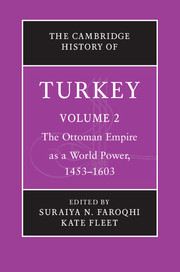Book contents
- Frontmatter
- Contents
- List of Illustrations
- List of Maps
- List of Contributors
- Chronology
- A note on transliteration
- Maps
- 1 Introduction
- Part I An Expanding Empire
- Part II Government, Economic Life and Society
- Part III Culture and the Arts
- 12 The order of knowledge, the knowledge of order
- 13 The visual arts
- 14 The literature of Rum
- Glossary
- Bibliography
- Index
- References
14 - The literature of Rum
The making of a literary tradition (1450–1600)
from Part III - Culture and the Arts
Published online by Cambridge University Press: 05 July 2013
- Frontmatter
- Contents
- List of Illustrations
- List of Maps
- List of Contributors
- Chronology
- A note on transliteration
- Maps
- 1 Introduction
- Part I An Expanding Empire
- Part II Government, Economic Life and Society
- Part III Culture and the Arts
- 12 The order of knowledge, the knowledge of order
- 13 The visual arts
- 14 The literature of Rum
- Glossary
- Bibliography
- Index
- References
Summary
A literary identity
Rum has pleasant water and air, and due to the extremely pleasurable water and air, the people of Rum are refined and each has everlasting excellence of character and abundant elegance of intellect. As a consequence, a poetic nature governs the people of Rum and they seek cultural attainment and knowledge. Due to this natural disposition, they have an inclination to poetry and those among them who conquer the domains of verse are countless.
In the conclusion to his biographical dictionary of poets, written around 1538, the Ottoman bureaucrat and poet Sehi Bey (1470–1549) explained the rise of a particular poetry in Anatolian Turkish by using the physical nature of its geographical location, “Rum”. Approximately 30 years later, in 1566, Aşık Çelebi (1520–72), a scholar and poet, further described Rum as “a target for Arabs and Persians and a source for Turkish and Deylamite poets”. In his introduction, he quoted many verses by bureaucrats and scholars of his time to support his claim that the climate of Rum was so conducive to poetry that even those Rum elite who lacked interest in poetry would burst into verse when faced with momentous events. For Sehi and Aşık Çelebi, Rum stood for western Anatolia and Rumeli, with Istanbul constituting its centre.
- Type
- Chapter
- Information
- The Cambridge History of Turkey , pp. 548 - 592Publisher: Cambridge University PressPrint publication year: 2012
References
- 5
- Cited by



